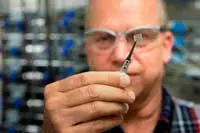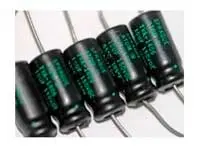Electronics News
Archive : 16 June 2016 год
 Researchers at the US Department of Energy's Argonne National Laboratory have used a small electric current to introduce oxygen voids that dramatically change the conductivity of thin oxide films. They say the discovery improves their understanding of how these materials work and could be useful for new electronics, catalysts or more.
Researchers at the US Department of Energy's Argonne National Laboratory have used a small electric current to introduce oxygen voids that dramatically change the conductivity of thin oxide films. They say the discovery improves their understanding of how these materials work and could be useful for new electronics, catalysts or more.
Oxides are a class of materials that has recently garnered interest because they sometimes display unusual behaviours: Flipping between insulating and conducting states, turning magnetism on and off, or even becoming superconducting.
The researchers think some of these properties have to do with oxygen vacancies. The structure of an oxide is a repeating crystalline lattice with oxygen atoms peppered throughout; but sometimes there may be voids where an oxygen atom is missing.
The usual way to create oxygen vacancies is by heating the materials and adding or removing oxygen from the environment. However, Jeff Eastman, Argonne materials scientist, said: “The need to control the gas environment limits where and when you can change the material's properties."
The Argonne team wanted to find out if they could control vacancies with an alternate method.
To do this they built a two-layer material: an indium oxide crystal layer on top of a block of yttria-stabilised zirconia. When the researchers applied a small electric field, they watched the electrical conductivity increase by two orders of magnitude along the boundary where the two layers meet. The effect is reversible; without the field, it reverts back to the initial, less conductive state.
"You could imagine applications for electronics or building catalysts. For example, providing a way to split water or carbon dioxide," Eastman said.
The theory, assisted by computational modelling, is that the difference between the two materials' properties creates a vertical voltage between them, and negatively charged oxygen ions in the indium oxide are attracted to the flow and move across the interface, leaving vacancies behind.
The team is planning further investigation into whether the same effects occur in other materials and whether the method could control other properties.
Pic: Argonne physicist Jeff Eastman holds a thin oxide film which dramatically increases its conductivity when a small current is applied. The discovery could be useful in studies for better electronics or catalysts.
Author
Tom Austin-Morgan
Source: www.newelectronics.co.uk
 A new type of supercapacitor material developed at the University of Amsterdam is said to have potential applications in electronics, transportation and energy storage devices.
A new type of supercapacitor material developed at the University of Amsterdam is said to have potential applications in electronics, transportation and energy storage devices.
Dr David Eisenberg and Professor Gadi Rothenberg of the University’s Van ‘t Hoff Institute for Molecular Sciences discovered the material during work on a fuel cells project. Originally, the materials were developed as solid catalytic electrodes, but by modifying the surface of these materials, the scientists created a porous compound suited for use in supercapacitors.
The material is said to be light, cheap and non toxic and can be prepared easily on a large scale. Dr Eisenberg noted: “Companies making electronic devices look for low-cost, highly reproducible materials with a low environmental impact. The literature abounds with reports of high-performance electronic materials, but these will only be applied if they can be made cheaply in large quantities.”
Supercapacitors combine the properties of capacitors and batteries. Batteries can store large amounts of energy, but their power density is low. Conversely, capacitors enjoy a high power density, but their energy density is low. And, while a battery uses its whole bulk for charge storage, a capacitor uses its surface. Supercapacitors have a higher energy density than regular electrolytic capacitors and a higher power density than batteries.
Typically, supercapacitors are used when many rapid charge/discharge cycles are required, such as in protecting electronic circuits against power surges and regenerative braking in cars.
Author
Graham Pitcher
Source: www.newelectronics.co.uk

